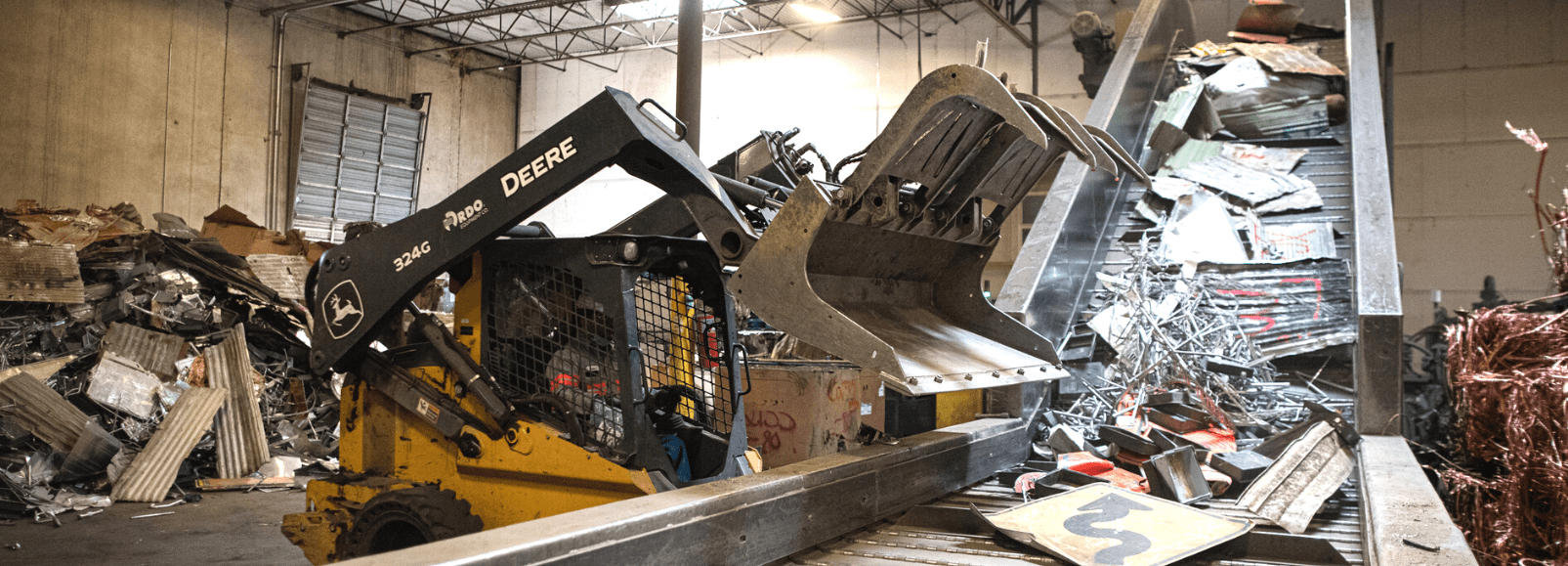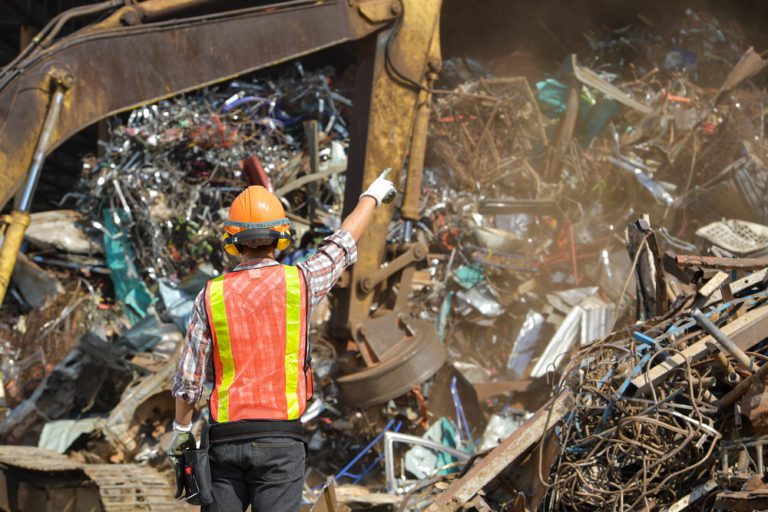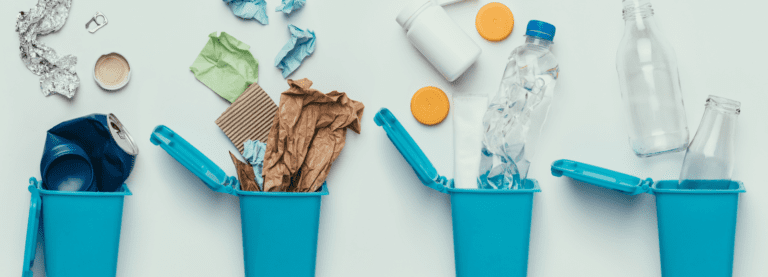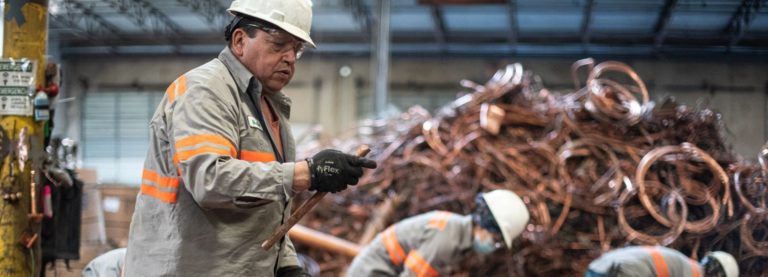What happens to old metal products thrown out by homes and businesses? It looks like trash, and some of it is, but how can you tell? And how difficult is the sorting process and recycling scrap metal? Learn how metal is recycled, step by step.
Metals that contain known or potential toxins are unrecyclable. Examples are motor oil cans, paint cans, and some pots and pans, among other contaminated items. Such materials belong in a hazardous waste dump. The remaining clean metals fall into ferrous (magnetic) and nonferrous (not magnetic) categories and most are easily reusable. In fact, most clean scrap is infinitely recyclable.
This guide explains how to sort scrap metal for recycling and the recycling process. Soon, you will know how it goes from being a waste to a resource. But first, a look at why recycling metals matters and how to identify the items suitable for reclaiming.
5 Benefits of Recycling Scrap Metal
There are five main reasons to recycle metal rather than dispose of it in the trash.
- Helps preserve finite natural resources
- Reduction in mining raw materials means less CO2 emissions
- Recycling metals uses less energy
- Less trash ends up in landfills
- Metal recycling creates jobs
Don’t forget the financial incentive, either. GEOMET Recycling pays individuals and businesses top rates to recycle your scrap metal.
How to Identify Recyclable Scrap Metal?
There are three straightforward ways to help you identify different metals. You can sort it by color, magnetic response, and weight [1]. Use the tables below as a guide.
Color to Identify Your Metal and Alloy Trash
| Metal or Alloy | Color |
| Brasses | Light yellow |
| Bronze | Dark yellow |
| Copper | Red or reddish |
| Copper-nickel (also cupronickel) | Tan or light brown |
| Gold | Dark yellow |
| Lead, zinc, and zinc alloys | Dark gray or bluish-gray |
| Most others | Light gray or white |
Metal and Alloy Magnetic Response
| Metal or Alloy | Magnetism |
| Cast iron | Strongly magnetic |
| Steel, stainless steel | Depends on alloy composition |
| Nickel | Strongly magnetic |
| Monel (alloys of nickel & copper) | Slightly magnetic |
| Aluminum bronze (copper-based alloy) | Slightly magnetic |
| Manganese bronze (bronze alloy) | Slightly magnetic |
| Silicon bronze (low-lead brass alloy) | Slightly magnetic |
| Most other metals | Nonmagnetic |
Metals and Alloys by Weight
| Metal or Alloy | Weight |
| Gold, tungsten, platinum | Extremely heavy |
| Lead, silver | Heavy |
| Magnesium, aluminum, titanium | Light |
| Most other metals | Intermediate weight |
There are other ways to identify what metal can be recycled. They include spark, chip, torch, hardness, and chemical tests.
OK, now let’s look at how the industry recycles ferrous and nonferrous metals.
The Scrap Metal Recycling Process Start to End
Recycling metals has grown in popularity in recent decades for obvious reasons, and we’re getting better at it all the time. Today, everything from cans to seafaring container vessels have scrap value. It’s why experts refer to metal as a “Permanently Available” material. So, let’s find out what happens to it all.
Scrap Metal Collection
There can be no scrap metal recycling program without collection, and that starts with you. Scrap metal is all around us, whether at your home or business. But individuals must sort the material before taking it to a processing facility. Designated bins are available for safely holding and storing metal scrap for domestic and commercial users.
Domestic Scrap
When you start to look for it, you’ll notice there are many old metal items around the home that are worth money. So pause the next time you plan to toss an old refrigerator, washer, microwave, or food can out with the trash. Consider selling it as scrap instead. Other potential money makers are electronic products, garden and patio furniture, old tools in the garage, etc. Scrap metal prices do fluctuate, so be sure to check the current rates before you sell.
Deliverable Scrap Metal Bins and Hoppers
GEOMET offers and delivers”roll-off” bins and hoppers to industrial, manufacturing and construction sites. And when you’ve filled your container, we come and take it away for processing. Our roll-off bins and hoppers offer an excellent revenue solution for construction sites and manufacturing facilities, without any cost to you.
Contact GEOMET Recycling to Learn More
The 4-Step Process of Metal Recycling
Whether it’s a brass button or a steel battleship, the first step to recycling scrap metal begins at a processing facility. There are four stages involved here.
- Sorting
- Cleaning
- Baling
- Loading
 Phase 1: Sorting
Phase 1: Sorting
A special facility sorts the metal based on the material, size, weight, and amount. Smaller items, such as cans, are loaded onto conveyor belts. The sorting process is usually a combination of manual and mechanical sorting to separate metal from debris and garbage. The procedure is similar for all scrap, but the equipment varies depending on the type.
Automated wire cutters remove the protected insulation to process wiring on mass. For small amounts, a handheld wire stripper or even household scissors will cut through the shielding easily enough. And motor vehicles are smashed before going into an industrial shredder rather than a baler.
But in all cases, metals are separated and categorized as part of the first recycling stage.
 Phase 2: Cleaning
Phase 2: Cleaning
The next step is to clean the sorted metal to remove paint, adhesives, plastics, foam, fabric, wood, etc. Also, some pieces of metal may require pressure washing to get rid of stubborn contaminants. When the scrap reaches the recycling facility, the metals are purified and as free as possible from non-metal materials.
 Phase 3: Baling
Phase 3: Baling
Sorted scrap enters a hydraulic baling machine that uses a unique pressing process. It crushes and distorts the metal into smaller pieces before wrapping it into neat bales, hence the name.
 Phase 4: Loading
Phase 4: Loading
Forklift trucks load the metal bales onto transportation. It’s then taken to metal recycling facilities such as steel mills and foundries. These plants have smelting and purification equipment that melts the material to prepare it for repurposing.
Recycling and Repurposing
Recycling and repurposing old metal are what make the preparation so worthwhile. This process melts the scrap and casts it into bricks of purified metal called ingots. Different metals undergo unique purification and melting processes such as electroforming or shredding. The end product is available for sale where it’s used to make new items.
Who Buys Recycled Metal?
All consumers buy products made with recycled metal, but most aren’t aware of it. And there is no shortage of industrial buyers for scrap. So, let’s look at the four biggest contributors to the material-to-material loop. Some of these may surprise you.
#1 Home Supplies
Your new home fixtures, fittings, and furnishings may contain recycled metal. There’s a good chance it’s used in furniture, lighting, roofing, and so on. Yard tools, television components, air conditioning units, and hot water systems are others. And these are all things that can be recycled again at the end of their lives.
#2 Food Packaging – What Goes Around Comes Around
The food and drinks cans you sorted for recycling often end up back on supermarket shelves. It’s true; the scrap is remade into a new product. And when you’re done with it, it goes through the entire recycling process again with no loss of quality. It’s a highly efficient and economical use of recycled metals, making the packaging industry a perfect example of the circular economy.
#3 Recycling Scrap Metal for Transportation
Train tracks, bridges, vehicles, aircraft, and shipbuilding all use high-quality recycled metal. Indeed, around eight million pounds of recycled aluminum get used in the construction of Boeing airplanes annually [2].
#4 Manufacturing
Manufacturing can use recycled metals in the same way as virgin materials. That’s because there’s no loss to its properties after the entire recycling process. Every metal item used to manufacture new products can originate from scrap. It’s often cheaper, more environmentally friendly, and infinite in supply.
The recycling rate of metals is going up year on year thanks to the recycling efforts of Americans. Of course, there’s still work to do, but the trend is up.
Rates of Recycling Scrap Metal in the US, 2019
There are approximately 10,530 tons of lead recycled each year globally. However, the most recycled metal by quantity is steel, followed by iron, aluminum, then copper. But the trend for recycling scrap metal continues to rise annually [3] [4] [5] [6].
Closing Comments
Consumers, manufacturers, and our environment all benefit from using recycled metals. First, it helps to keep the costs of products down. Recycling also means less waste material and harmful substances ending up in US landfills. And that results in fewer chemicals leaching into the soil and contaminating precious groundwater.
Moreover, recycling uses less energy than processing metal from extracted ore. And lastly, the less we mine, the less disruption there is to natural habitats.
Resource Links
- https://www.911metallurgist.com/identifying-scrap-metals/
- https://www.aerospace-technology.com/recycle-aluminium-scrap-boeing/
- https://www.midlandlead.co.uk/recycling-lead/
- https://pubs.usgs.gov/periodicals/mcs2021/mcs2021-iron-steel-scrap.pdf
- https://en.wikipedia.org/wiki/recycling-aluminum-copper/
- https://www.marketwatch.com/metal-recycling-emerging-trends/






